 |
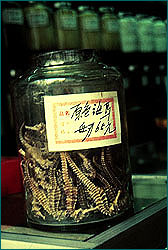 NOVA: Are they used mainly as aphrodisiacs?
NOVA: Are they used mainly as aphrodisiacs?
AV: No, they're used for a whole range of ailments. Seahorses are used to
treat asthma, and arteriosclerosis, and incontinence and impotence and thyroid
disorders and skin ailments and broken bones and heart disease. And even to
facilitate childbirth, although it depends a little bit on the region. In Hong
Kong, they're used primarily for asthma and for impotence. In Taiwan they're
used an awful lot for an aphrodisiac or to promote sexual function.
NOVA: What sort of testimonials have you heard from people who have used
seahorses and found them effective?
AV: We've talked a lot to traditional Chinese medicine users and they're
convinced that seahorses work, which is one reason why we don't take the
arrogant perspective of dismissing it as superstitious nonsense. Instead we're
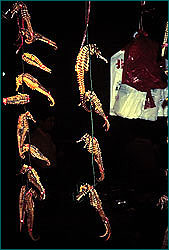 trying very hard to set up a new approach whereby we respect the conviction
that these are medically useful, at the same time pointing out that the loss of
these animals in wild populations would penalize Chinese medicine as much as it
would penalize those who respect them for their conservation value. Really,
when you think about it, the people who catch the seahorses need there still to
be seahorses so that they can continue earning an income. The people who use
seahorses for medicines need there still to be seahorses to treat their
illnesses. And we, who primarily are concerned about the conservation issues,
want there to be seahorses. And there's got to be a way of harnessing these
three different converging needs for seahorses in the wild.
trying very hard to set up a new approach whereby we respect the conviction
that these are medically useful, at the same time pointing out that the loss of
these animals in wild populations would penalize Chinese medicine as much as it
would penalize those who respect them for their conservation value. Really,
when you think about it, the people who catch the seahorses need there still to
be seahorses so that they can continue earning an income. The people who use
seahorses for medicines need there still to be seahorses to treat their
illnesses. And we, who primarily are concerned about the conservation issues,
want there to be seahorses. And there's got to be a way of harnessing these
three different converging needs for seahorses in the wild.
NOVA: You just got back from Asia?
AV: Yes, I just got back at the end of February 1997.
NOVA: Where were you and what were you doing?
AV: I was in the Philippines and Vietnam and Hong Kong. In Vietnam, I was
checking up on a project I have there with four biologists from the Institute
of Oceanography. We're just beginning village training on raising seahorses in
captivity with the idea of providing local fishers with an alternative to
catching the wild seahorses.
NOVA: I understand that raising seahorses in tanks is a real challenge. Why
is that?
AV: Seahorses are tricky little creatures. They need to eat live food only.
They're really voracious predators contrary to their sort of pleasant benign
appearance. And seahorses also get a lot of diseases. So rearing baby
seahorses is an exercise in trying to draw together a whole host of different
tiny food sources, which means you have to culture the algae to feed the little
food items to feed the seahorses. And it's complicated to do that well enough
to have reliable supplies for large numbers of animals.
NOVA: What are you working on in the Philippines?
AV: In the Philippines I work with a non-governmental organization called the
Haribon Foundation for the conservation of natural resources. We just launched
a new initiative which we're calling "grow-out cages." The grow-out cages are
corrals in the sea, built by the fishers from confiscated nets from people
who've been fishing illegally. The fishers have to continue catching the very
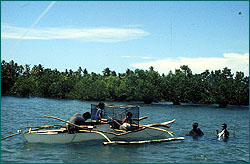 small seahorses, the juveniles, because if they don't catch them other people
in the region will. And these fishers need the income desperately to provide
the rice for their families. So now we have an agreement whereby when they
catch these juvenile seahorses, they will be paid from a small loan we've given
them. But the seahorses will not be sold. Instead they're going to be put
into these corrals in the sea, and they'll grow up there for five months. At
the end of that time, the fishers will pay us back the loan, but they'll be
able to sell the seahorses for double the initial value, because now they're
larger. So this gives the fishers more money. The advantage to conservation
is that halfway during this grow-out period, the seahorses will start
reproducing. So for about two and a half months, the seahorses in the corrals
will be releasing their young into the sea. The young will escape through the
nets and re-populate the wild regions.
small seahorses, the juveniles, because if they don't catch them other people
in the region will. And these fishers need the income desperately to provide
the rice for their families. So now we have an agreement whereby when they
catch these juvenile seahorses, they will be paid from a small loan we've given
them. But the seahorses will not be sold. Instead they're going to be put
into these corrals in the sea, and they'll grow up there for five months. At
the end of that time, the fishers will pay us back the loan, but they'll be
able to sell the seahorses for double the initial value, because now they're
larger. So this gives the fishers more money. The advantage to conservation
is that halfway during this grow-out period, the seahorses will start
reproducing. So for about two and a half months, the seahorses in the corrals
will be releasing their young into the sea. The young will escape through the
nets and re-populate the wild regions.
NOVA: How much money is involved in the loans?
AV: Oh, they're micro loans. I mean tiny amounts. For example, each baby
seahorse that comes in is worth three pesos. And that's about 12 cents. And
we expect to have two to three hundred seahorses in each corral. So we're not
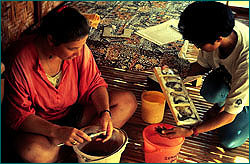 talking about huge amounts of money. But for the fishers, it's an
insurmountable amount to raise themselves. We recognize that the reason
people fish the seahorses too heavily is the lack of other economic
alternatives and the lack of education to find other alternatives. So another
thing we've done is set up high school scholarships. In our village, very,
very few children make it to high school—less than ten kids were at high
school. So we provided the opportunity for two more kids to go to high school,
and in exchange they spend every weekend with us as apprentices in
conservation, working on the project and communicating what we're doing to
other villagers and leading programs for younger children in marine
conservation, particularly with respect to seahorses.
talking about huge amounts of money. But for the fishers, it's an
insurmountable amount to raise themselves. We recognize that the reason
people fish the seahorses too heavily is the lack of other economic
alternatives and the lack of education to find other alternatives. So another
thing we've done is set up high school scholarships. In our village, very,
very few children make it to high school—less than ten kids were at high
school. So we provided the opportunity for two more kids to go to high school,
and in exchange they spend every weekend with us as apprentices in
conservation, working on the project and communicating what we're doing to
other villagers and leading programs for younger children in marine
conservation, particularly with respect to seahorses.
NOVA: And what about your work in Hong Kong?
AV: In Hong Kong we're considering starting a new project. There the idea
would be to hire somebody who is ethnic Chinese to work with the traditional
medicine community in Hong Kong and China in order to discuss with them
possibilities that could replace seahorses. So to look through their
repertoire of medical alternatives to seek species that are not at risk and
encourage medical use of those instead of seahorses.
NOVA: Are people generally receptive to what you're trying to do?
AV: Doing community based work in Vietnam is complicated because the political
tradition recently hasn't allowed for much individual input. Working with
communities in the Philippines is a lot easier because the Philippines has a
long tradition of community-based work. We find that villagers usually can
identify the problems at least as quickly as we can. So it's not that fishers
don't recognize they are over-fishing. They do. But they're extremely poor.
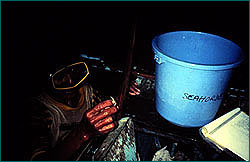 Our focal community in the Philippines is one of the poorest villages in a poor
municipality in a poor province of a very poor country. And seahorses provide
about half the annual cash income for about a quarter of the households in the
village. Clearly they're an important resource. When we discuss with the
fishers ways forward they're full of suggestions and very happy to evaluate our
suggestions and then try the ones that we mutually feel are possible. The
Our focal community in the Philippines is one of the poorest villages in a poor
municipality in a poor province of a very poor country. And seahorses provide
about half the annual cash income for about a quarter of the households in the
village. Clearly they're an important resource. When we discuss with the
fishers ways forward they're full of suggestions and very happy to evaluate our
suggestions and then try the ones that we mutually feel are possible. The
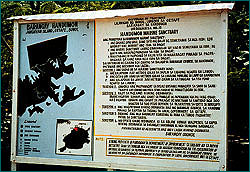 villagers set up a marine sanctuary for all species, not just for seahorses.
And it's been strictly their baby. They've policed it, they've enforced it,
and they're very proud, as they should be, of its rather rapid recovery. The
fishing around the reserve has now gone up, and this means that more and more
villagers believe that this is a good idea. To the point where other villages
are now asking our involvement to establish their own sanctuaries because
they've heard from their friends and seen with their own eyes how much
difference it makes.
villagers set up a marine sanctuary for all species, not just for seahorses.
And it's been strictly their baby. They've policed it, they've enforced it,
and they're very proud, as they should be, of its rather rapid recovery. The
fishing around the reserve has now gone up, and this means that more and more
villagers believe that this is a good idea. To the point where other villages
are now asking our involvement to establish their own sanctuaries because
they've heard from their friends and seen with their own eyes how much
difference it makes.
NOVA: That must be gratifying.
AV: It's really nice to see. Just to realize that you're meeting a need and
to be asked for help instead of to try to encourage them to accept help.
NOVA: And in Hong Kong?
AV: In Hong Kong, we've found that the traditional Chinese medicine community
is very happy to discuss ways of addressing conservation concerns. There's
been a long history of confrontation between conservationists and traditional
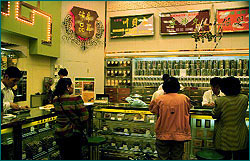 medicine communities. TRAFFIC, which is the international agency that monitors
the trade in endangered animals and plants, started a new dialogue, a new
paradigm about a year and a half ago when they arranged a workshop with the
traditional medicine community and conservationists with simultaneous
translation. And they found that once discussion began, the Chinese medicine
community was very receptive. But it is not in the Chinese culture to be
aggressively confrontational, which is the way most western conservation bodies
had addressed the issue. So we find when we sit down with a bit of give and
take in a dialogue there is a willingness to discuss possible ideas, and we're
hoping to capitalize on that by developing a new program to adjust the demand
for seahorses which is growing extremely rapidly—mostly because of China's
economic growth.
medicine communities. TRAFFIC, which is the international agency that monitors
the trade in endangered animals and plants, started a new dialogue, a new
paradigm about a year and a half ago when they arranged a workshop with the
traditional medicine community and conservationists with simultaneous
translation. And they found that once discussion began, the Chinese medicine
community was very receptive. But it is not in the Chinese culture to be
aggressively confrontational, which is the way most western conservation bodies
had addressed the issue. So we find when we sit down with a bit of give and
take in a dialogue there is a willingness to discuss possible ideas, and we're
hoping to capitalize on that by developing a new program to adjust the demand
for seahorses which is growing extremely rapidly—mostly because of China's
economic growth.
NOVA: What mysteries are left with regard to seahorses?
AV: There's so much we don't know about seahorses that I hardly know where to
begin explaining it to you. Believe it or not we don't know how long they
live. We don't know whether males and females eat differently. We don't know
if pregnant males eat differently. We don't know about their growth rates over
their life. We don't know a whole lot about what determines how many young the
seahorses actually have and whether some conditions will favor them producing
better and more young. We don't know how they choose their partners initially
when they want to pair. We don't know very much about what eats them. Believe
it or not, I did the first underwater study on seahorses as a biologist only
about six or seven years ago. And we still only have one or two other studies
in the whole world going on underwater for about 35 species of seahorse. So we
haven't even studied most seahorses in the wild. There's almost a limitless
list of questions that people can address.
NOVA: Where can people interested in seahorses get more information?
AV: Two colleagues, Dr. Heather Stanley and Dr. Helen Hall, and I have formed
an umbrella program called Project Seahorse. Our Web site is at
http://www.anyware.co.uk/seahorses/ and if anybody is interested, obviously
we'd love to hear from them.
Photos: (1-2, 4-12) © Amanda Vincent; (3) © James Beveridge/Visuals Unlimited.
Seahorse Home | Crusader | Basics | Superdads
Roundup | Resources | Table of Contents
|